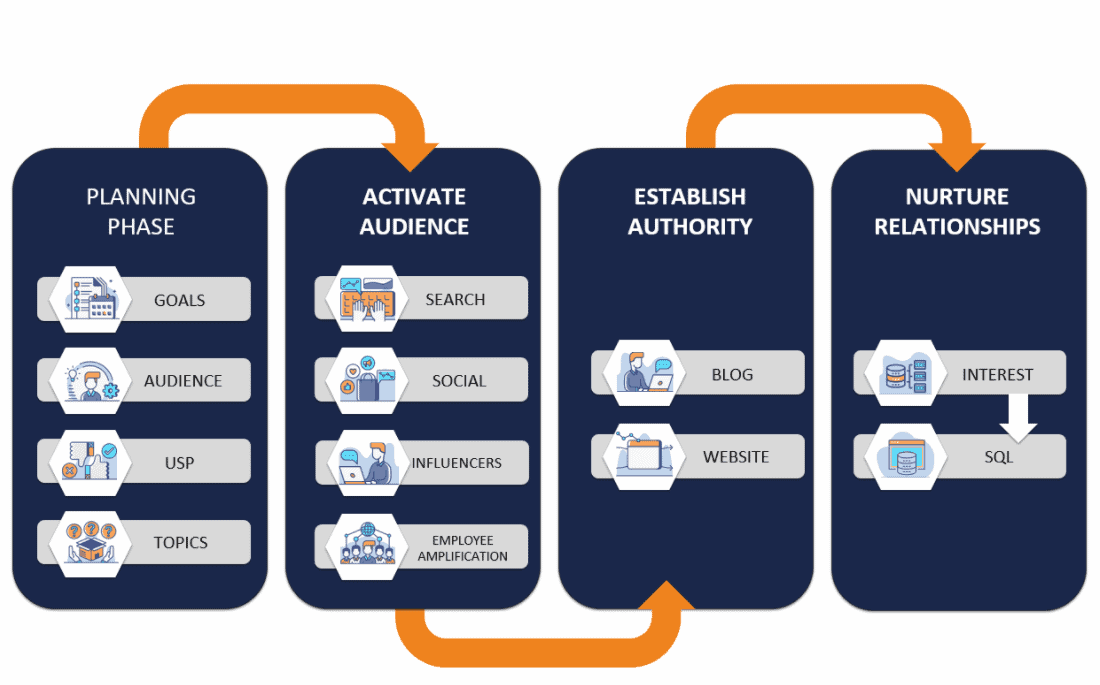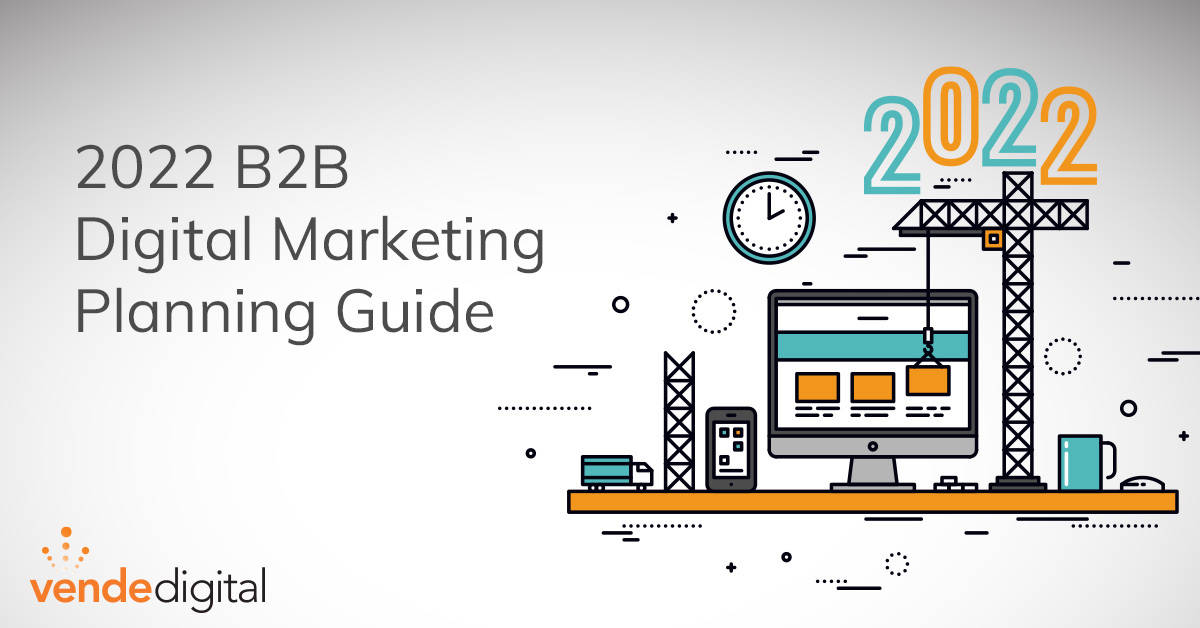5 Steps for identifying, attracting, and converting your best customers
Now might be the best time ever to be in B2B marketing. We have so many digital channels to get in front of buyers. Buyers are actually using these same digital channels to learn and discover solutions to their problems. It’s a perfect scenario!
You’d better believe your competition will be thinking seriously about the best ways to leverage digital marketing too.
To win in 2022, don’t try to do everything and be everywhere. Follow this B2B digital marketing planning guide to develop a plan that gives you the best chance for success.
What should be in a B2B Digital marketing plan?
A good B2B digital marketing plan should define your strategy to generate attention and aid the buyer in their journey from unaware that your company exists to saying ‘yes!’ to your solution. Your plan should include:
- Defined Target Audience (who is your customer) – Always begin with defining your ideal customer, their pain/problems, and how your company specifically addresses their pain. In B2B, this would include geographic, firmographic, and psychographic elements.
- Measurable Goals (what does winning look like) – Define digital marketing goals that align with the macro goals of the business. (example: $1M in marketing-sourced pipeline)
- Strategy/Plan (how will you get there) – There are multiple ways to accomplish marketing goals. Document your strategy/plan on how to achieve the goal. Try to limit your plan to 1-3 key components. Any more and you’ll be spread too thin. (example: We will (a) run a Full-funnel digital advertising campaign; (b) execute a nurture email campaign to prospects in targeted accounts, and (c ) develop and distribute useful content to our audience)
- High-Level Tactics (what will you need to do) – These are the specific steps needed to execute the strategy. (Example: Promote weekly blogs to target audience via social media, retarget website visitors with a gated offer, invite opt-ins to quarterly webinars, etc.)
- Advertising/marketing Budget (how much will you spend) – There are many ways to determine your budget. The most common are: a percent of revenue, Customer Acquisition Cost (CAC) multiplied by total number of new customers, or an increase/decrease of the previous year’s budget.
Keys to Successful B2B Digital Marketing Planning
Before we get to our 5 step planning framework, let’s review some important guardrails to keep you from getting off track. Be sure to keep these in mind:
- Don’t try to do too much – Since there are so many options out there, it is easy to fall into the trap of throwing everything at your goals. Avoid this temptation by picking 2-3 strategies and 2-3 tactics for each strategy. Then focus on executing them well.
- Keep it high level – Annual planning and campaign planning are different functions. When building an annual plan, you aren’t trying to flush out all the specific details of campaigns that will run throughout the year. Your plan should stay high-level and connect the dots between Goal-Plan-Tactics.
- Build a balanced strategy that has tactics for each stage of the marketing funnel. Plan to execute tactics to create awareness, generate traffic and leads, and stay top-of-mind.
- Learn from the past – Look back and identify things you can stop doing (because they aren’t helping) and what things you should scale (because they are working well).
- Don’t forget to leave room to test and try things – It’s important to be able to test new channels and tactics. However, it’s hard to get the budget for this unless you plan for it.
- Sandbag a little 🙂 – Don’t set yourself up for failure by having to make shots from half court to achieve your goal.

B2B Digital Marketing Trends for 2022
Real quick, before we get to the planning process; be sure to consider how to work in some of the following digital marketing trends we are seeing starting to take off:
- Focus on Demand Generation vs. Lead Generation: It’s not about getting someone to buy something this very minute. When you focus on demand generation marketing, the goal is to establish yourself as the preferred vendor before the buyer moves into a buying cycle.
- Deliver more value in channels where your customers go to learn: Stop thinking about your website as the only place to deliver value. How can you repurpose information from your website and make it available on social media?
- Ungate most of your content: This will maximize the number of buyers that can benefit from your knowledge.
- Spend more of your budget on awareness: Plan on expanding your Top of Funnel (ToFu) media budget. Make sure to focus on channels where you deliver actual value “on channel” with your ad.
- Align content creation around content pillars: Develop useful long-form content (for example; blogs, guides, webinars, etc.) tied to key areas of expertise that can be easily repurposed for different channels.
5 Steps to Develop Your B2B Digital Marketing Plan
Now that the prerequisites are out of the way, let’s dig in and build a B2B digital marketing plan for identifying, attracting, and converting your best prospects.
Step 1: Leverage a Framework: Here’s the framework that we use to build go-to-market digital strategies for our clients. We believe that successful B2B campaigns need a well-documented plan that enables you to:
- Activate Your Audience by getting your message in front of targeted buyers;
- Drive prospects to your website so you can Establish Authority & Empathy;
- Nurture Relationships over time, so prospects think of you first when they are ready to buy.

You don’t have to use ours, but it’s helpful to have a basic system that ties everything together. This will keep you focused and help troubleshoot and analyze performance once implemented.
Step 2: Identify the What and the Who: Start by documenting what company goals and desired outcome(s) you want to use to measure success. A good starting point is to get direction from your CEO about their vision for the next year. Ask yourself:
- What levers can marketing pull to help achieve the vision?
- What would winning look like?
Then you can use our B2B Digital Marketing Budgeting Calculator to back into lead and traffic goals.
Every plan must also communicate who you are trying to reach. A great plan would focus on an Ideal Customer Profile (ICP), that subset of customers that love you are most able to serve. This enables you to refine the rest of your marketing plan.
Step 3: Determine how you will activate your audience: This begins with understanding what digital channels your prospects go to for education and industry-related networking. Include in your plan ways to engage and distribute information to your audience within these channels. Pick 1-2 channels you want to dominate over the next year and also pick a new channel to explore. From there, you need to think through:
- How will you distribute your content? (paid/social)?
- How will you target your audience? (on-channel, engagement, intent, ABM, etc.)?
- What is your influencer strategy? (happy clients, podcasts, review sites, etc.)?
- What will you need Sales to do to support your plan?
Step 4: Identify what you will do on your website to establish authority and empathy: Your website is your most important buyer enablement channel. Once you have prospects on your site, they need to understand how you are both qualified to solve their problem and that you care about solving their problem.
Take a look at your home page, services pages, blog, landing pages, and contact pages. Do you need to tune any of these up and improve messaging? For help with this, be sure to leverage our Website UX Checklist to identify areas of your website to improve.
Step 5: Determine your plan for staying top of mind during the sales process: We can’t control when a prospect will be ready to say ‘yes!’ but we can control that when they are ready, they think of you before the competition. The key here is to develop a plan that touches prospects often and in multiple channels and ways. According to Ziff Davis, when brands engage with buyers via email, sales, and social media, conversion rates increase by 30%.
Think through these prompts to identify areas to optimize and work into your B2B digital marketing plan:
- What can you do to improve Website, MQL, and SQL conversion rates?
- How will you warm up leads for the sales team?
- What can you add to your website that would reveal intent from the buyer? (i.e. chat, online demo, configurator, ROI calculator, etc.)
Now Go and Build a Winning B2B Digital Marketing Plan for Your Business!
Remember, it’s the best time ever to leverage digital marketing to attract and convert your best customers. You now have our framework, resources, and the steps you need to take to build a solid plan. The ball is in your court.
Key Takeaways:
- Be sure to include both demand generation and lead generation strategies and tactics into your plan.
- Follow a framework to ensure you build your plan around key stages of the buying journey.
- Building a solid B2B digital marketing plan requires well-defined goals, a target audience, and documented strategies and tactics to move the audience down the funnel.
- Activate your audience by sharing valuable content on channels where they go to learn.
- Establish authority and empathy by communicating that your company is qualified to solve their problem and that you want to solve their problem. The best place to do this is on your website.
- Stay top of mind and nurture relationships by leveraging a combination of social, email, and sales outreach to maximize your chances to win.
How Can We Help?
Finding the time to build and execute a strategy like this can be challenging. We’ll be here if you need anything else. You can always schedule a complimentary discovery meeting with our team. We’ll take the time to learn about your business and give you an action plan on how to achieve your goals.


